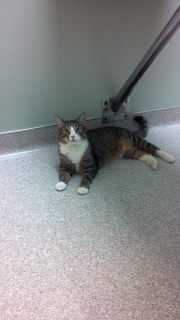I have to bring the cat carrier inside tonight. It sits in the garage when it’s not being
used (most of the time), and when we have a vet visit scheduled, it comes
inside the evening before. The cats will
usually come sniff it, get inside it for a bit and then walk off and ignore
it. Ginger and Chase are usually pretty
easy to catch and transport.
It’s Chase’s turn to go to the Vet. He will be there for the day while they do a
BG (blood glucose) curve. Chase is a
Diabetic. My sons are also both Type 1
Diabetics so I find it a little ironic that I ended up with a Diabetic cat,
too. Lucky me.
In February 2007 when Alex was 11, he was losing huge
amounts of weight, drinking lots of water and juice and seemingly eating
nothing. I thought at first that he had
an eating disorder. Food has always been
an issue with him. Because he’s also
Autistic, you cannot force him to do anything he doesn’t want to do. He eats what he eats and has always been that
way. The pediatrician tested Alex’s blood sugar levels. Then after taking one look at Alex, the
Doctor booked Alex (and me) a two-night stay at Strong Hospital to learn how to
manage life as a Diabetic.
Later that same year (in November) Matt had his annual
physical, and the Doctor told us he was in the beginning phase of Diabetes, too. Since we already knew a lot about Diabetes,
it was just a matter of teaching Matt how to test blood sugars and give insulin
injections.
Diabetes is not fun, but it can be managed and you learn to live
with it. The worst part is the Doctor’s
visits every few months. It’s hard (especially for a kid) not
to feel defensive when someone looks at your numbers (blood sugar reads, carb
intake and insulin dosages) and asks all sorts of questions. It’s hard not to feel like you’re being graded
on some difficult test when they test your A1c level. “The hemoglobin A1c test -- also called
HbA1c, glycated hemoglobin test, or glycohemoglobin -- is an important blood
test used to determine how well your diabetes is being controlled. Hemoglobin
A1c provides an average of your blood sugar control over a six to 12 week
period and is used in conjunction with home blood sugar monitoring to make
adjustments in your diabetes medicines.” And it can be (frankly) a little
boring to meet with the nutritionist and have her suggest all kinds of foods
that you know your fussy children will never even try.
We adopted our cat Chase in 2010 when he was around
2-1/2. He was given up for adoption by a
young man who had developed severe allergies and could not keep him any
longer. He is a wonderful cat – very friendly
and very mellow. His only fault is he’s
a little bossy and likes to push our older, more timid cat Ginger around. Chase
wants to be the top cat and likes to chase her around (he lives up to his name
anyway). Chase was well and healthy, and he was on his way to being a
little chubby. He loves food, and he ate
well when he got here. Out of the blue,
he started to lose weight. It seemed
like overnight, he was bonier – you could see his hips and spine. We took him to the vet and found out that he,
too, has Diabetes and would need twice daily insulin injections. I thought I was through giving shots once the
boys had learned how to do their own. I
was wrong.
Since Chase is so mellow, he is very easy to medicate. We have a routine. I grab the bag of cat treats, sit down at the
table and get his injection ready. He
comes over for the treat, and when he is finished eating, he turns his back to
me and waits beside my feet for me to pick him up. I give him his shot, put him down, and he
gets another treat or two. I couldn’t
ask for an easier “patient”.
So he sees the Vet tomorrow to check to see how he’s doing
on a higher dose of insulin. We are
still working at getting his blood sugar reads to an acceptable level. He has to fast (no breakfast and no insulin),
and they test his level when he gets there while he’s empty. They then feed him and give him his insulin,
and they test him again. They then test
him every few hours. That way they get a
BG curve. They can see his highest level
and his lowest level and decide whether the dose of insulin is appropriate or
not – they can see how much the insulin brings the blood sugar level back down
and how quickly the level rebounds and starts to go back up again. At least he
doesn’t have to suffer through a session with a nutritionist!







No comments:
Post a Comment